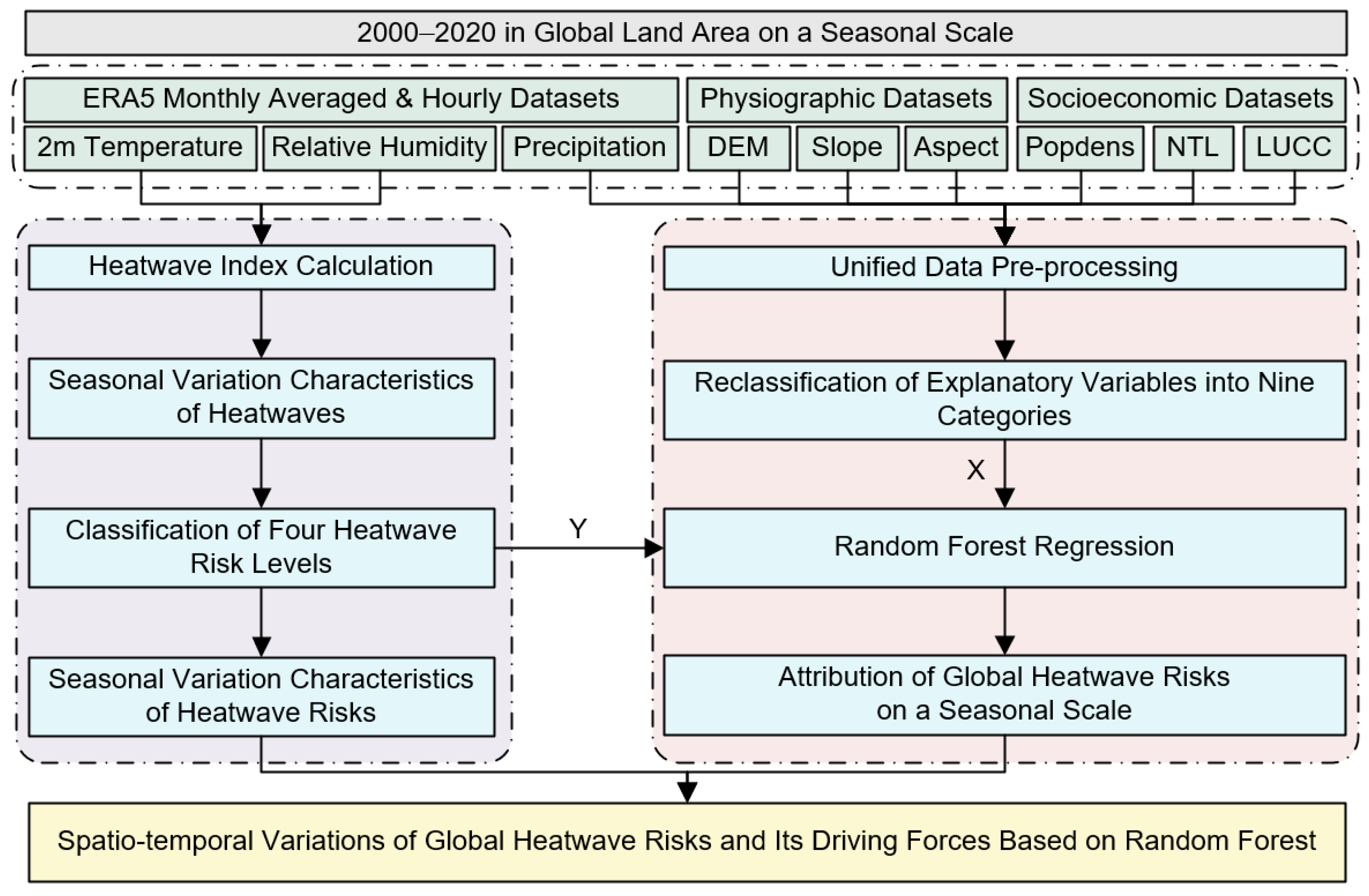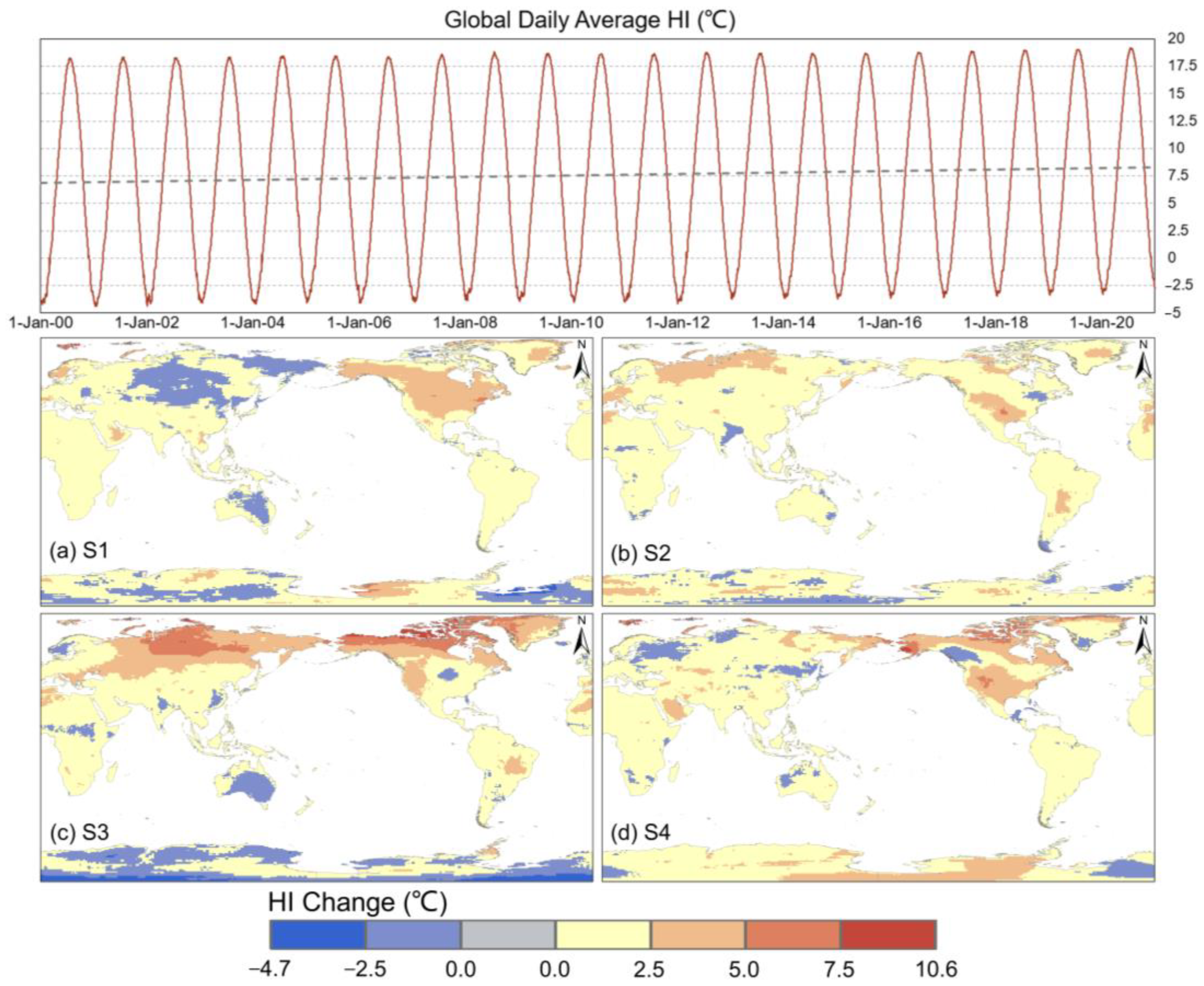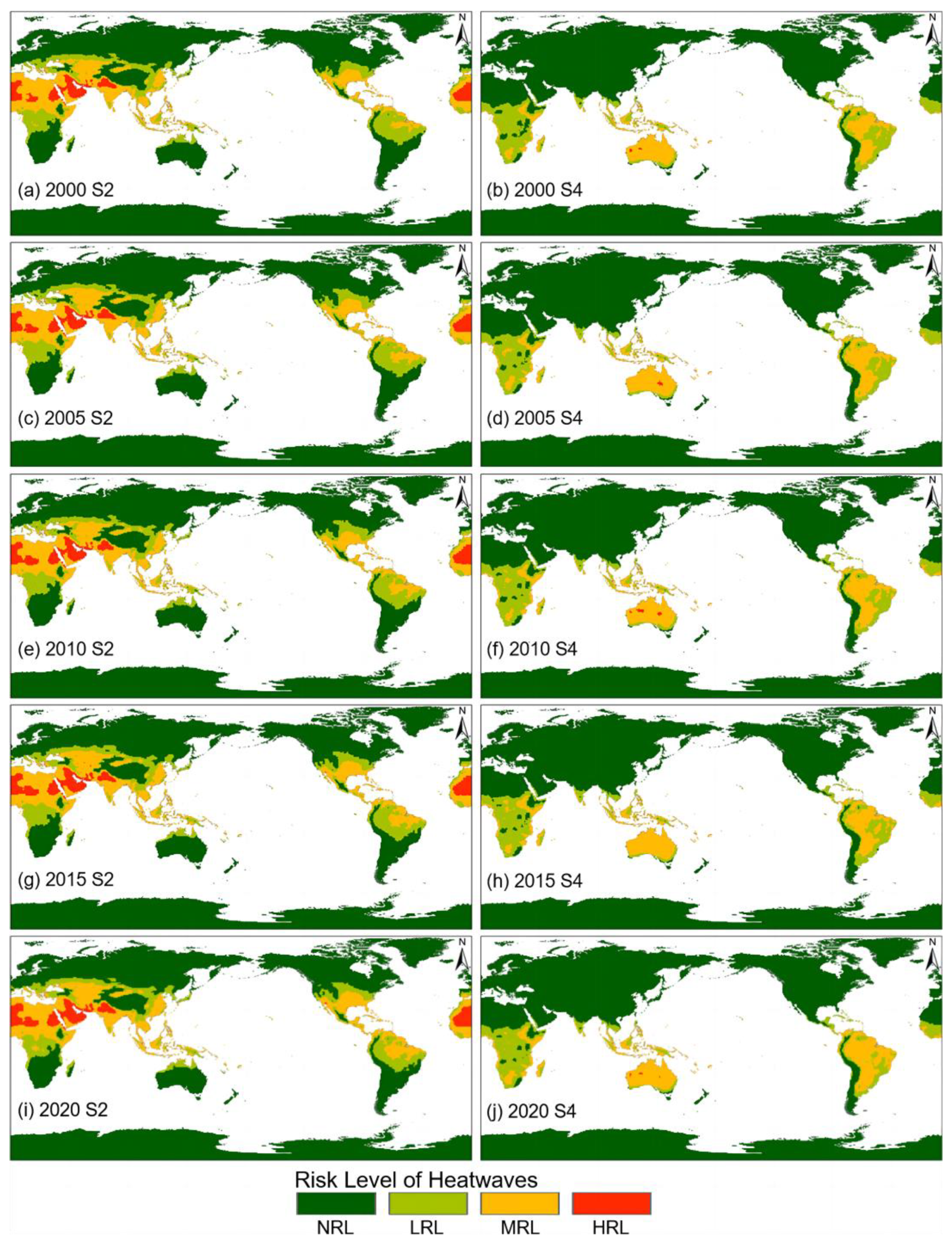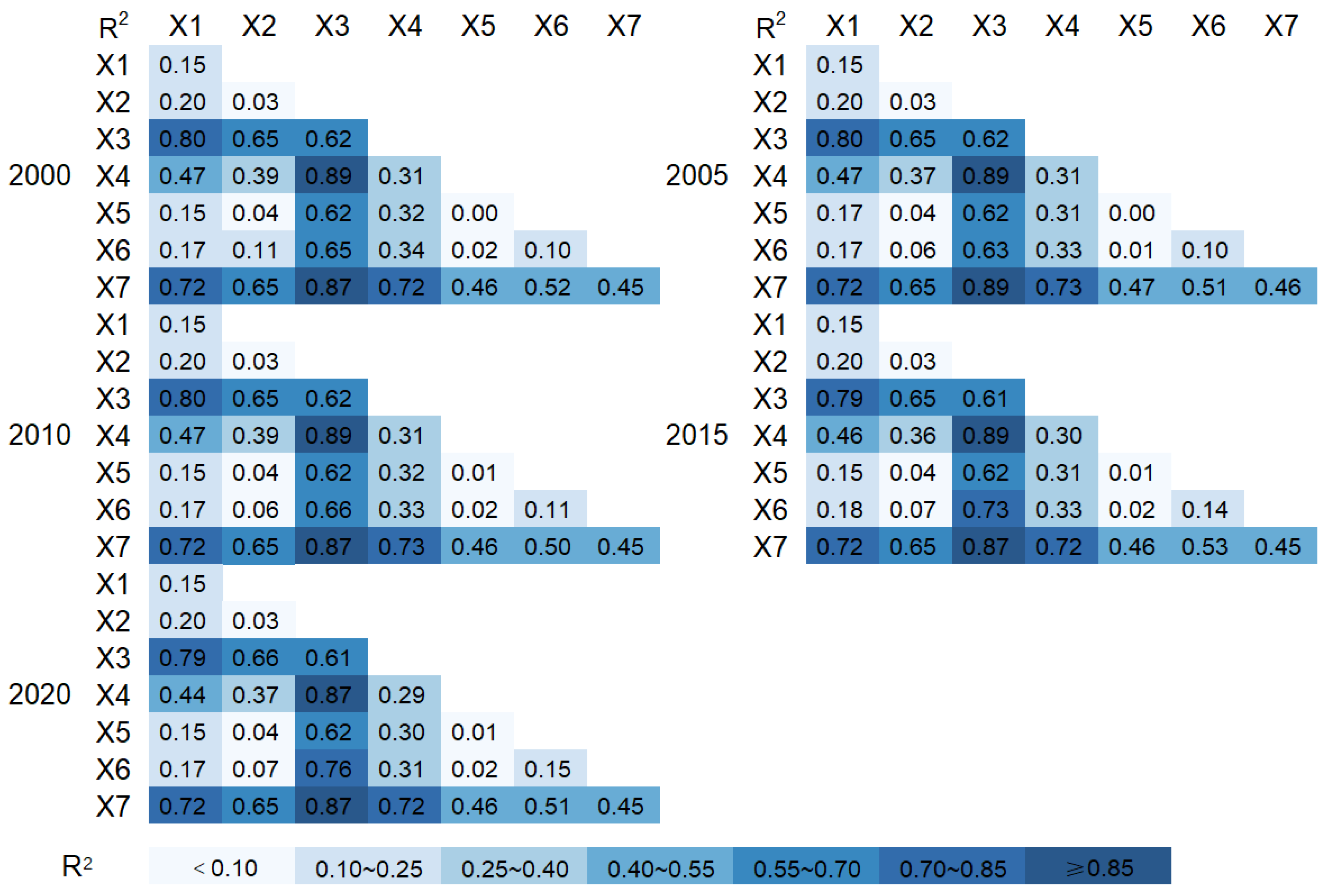Spatiotemporal Variations of Global Human-Perceived Heatwave Risks and their Driving Factors Based on Machine Learning
Abstract
1. Introduction
2. Materials and Methods
2.1. Data Sources
2.2. HI and Heatwave Risk
2.3. Random Forests
3. Results
3.1. Spatiotemporal Characteristics of Global Heatwaves
3.1.1. Global HI
3.1.2. Global Heatwave Risk
3.2. Attribution of Global Heatwaves
3.2.1. Single Driving Factor
3.2.2. Interaction Driving Factors
4. Discussion
4.1. Global HI and Heatwave Risks
4.2. Attribution of Global Heatwaves
4.3. Possible Targeted Measures
4.4. Limitations in Present Study
5. Conclusions
- Since the 21st century, changes in HI have varied significantly worldwide, with the majority of regions witnessing an increase, particularly at higher latitudes. The area of the HI-increasing region was larger in S2 and S4, and the largest HI-increasing area was observed in S2, while the overall HI increase peaked in S3;
- Except for the decreasing area of no-risk regions, regions under all other risk levels expanded (the proportion of high-risk regions increased from 2.97% to 3.69% in S2, and from 0.04% to 0.35% in S4);
- Aspect exhibited the most substantial influence on the spatial distribution of global heatwaves (0.69–0.76), followed by LUCC (0.48–0.55) and precipitation (0.16–0.43). In contrast, slope and NTL exhibited negligible effects, essentially having no impact on the global heatwave distribution;
- From 2000 to 2020, the explanatory power of the factors underwent a minor decrease without a significant trend but showed seasonal periodicity. The overall explanatory power of each factor was relatively high in S1 and S2 and low in S4. The explanatory power of climatic and land use factors was the highest in S1, and that of topographic and other human factors was the highest in S2;
- There was no significant trend in the attribution results of the interaction factors over the years, but the explanatory power of DEM and slope increased notably when interacting with the climate factor, aspect, and LUCC, respectively. The explanatory power of aspect and LUCC interacting with precipitation reached the maximum value (above 0.85) under all interactions.
Author Contributions
Funding
Data Availability Statement
Conflicts of Interest
References
- Mora, C.; Dousset, B.; Caldwell, I.R.; Powell, F.E.; Geronimo, R.C.; Bielecki, C.R.; Counsell, C.W.W.; Dietrich, B.S.; Johnston, E.T.; Louis, L.V.; et al. Global risk of deadly heat. Nat. Clim. Chang. 2017, 7, 501–506. [Google Scholar] [CrossRef]
- Watts, N.; Amann, M.; Arnell, N.; Ayeb-Karlsson, S.; Beagley, J.; Belesova, K.; Boykoff, M.; Byass, P.; Cai, W.; Campbell-Lendrum, D.; et al. The 2020 report of The Lancet Countdown on health and climate change: Responding to converging crises. Lancet 2020, 397, 129–170. [Google Scholar] [CrossRef]
- Carleton, T.; Jina, A.; Delgado, M.; Greenstone, M.; Houser, T.; Hsiang, S.; Hultgren, A.; Kopp, R.E.; McCusker, K.E.; Nath, I.; et al. Valuing the global mortality consequences of climate change accounting for adaptation costs and benefits. Q. J. Econ. 2022, 137, 2037–2105. [Google Scholar] [CrossRef]
- Burke, M.; Hsiang, S.M.; Miguel, E. Global non-linear effect of temperature on economic production. Nature 2015, 527, 235–239. [Google Scholar] [CrossRef] [PubMed]
- Dunne, J.P.; Stouffer, R.J.; John, J.G. Reductions in labour capacity from heat stress under climate warming. Nat. Clim. Chang. 2013, 3, 563–566. [Google Scholar] [CrossRef]
- Sun, Q.; Miao, C.; Hanel, M.; Borthwick, A.G.; Duan, Q.; Ji, D.; Li, H. Global heat stress on health, wildfires, and agricultural crops under different levels of climate warming. Environ. Int. 2019, 128, 125–136. [Google Scholar] [CrossRef] [PubMed]
- Ye, D.; Yin, J.; Chen, Z.; Zhen, Y.; Wu, R. Spatiotemporal Change Characteristics of Summer Heatwaves in China in 1961–2010. Adv. Clim. Chang. Res. 2013, 9, 15–20. [Google Scholar]
- Perkins, S.E.; Alexander, L.V.; Nairn, J.R. Increasing frequency, intensity and duration of observed global heatwaves and warm spells. Geophys. Res. Lett. 2012, 39, L20714. [Google Scholar] [CrossRef]
- Sun, Y.; Zhang, X.; Zwiers, F.W.; Song, L.; Wan, H.; Hu, T.; Yin, H.; Ren, G. Rapid increase in the risk of extreme summer heat in Eastern China. Nat. Clim. Chang. 2014, 4, 1082–1085. [Google Scholar] [CrossRef]
- Mitchell, D.; Heaviside, C.; Vardoulakis, S.; Huntingford, C.; Masato, G.; Guillod, B.P.; Frumhoff, P.; Bowery, A.; Wallom, D.; Allen, M. Attributing human mortality during extreme heat waves to anthropogenic climate change. Environ. Res. Lett. 2016, 11, 074006. [Google Scholar] [CrossRef]
- Matthews, T.K.R.; Wilby, R.L.; Murphy, C. Communicating the deadly consequences of global warming for human heat stress. Proc. Natl. Acad. Sci. USA 2017, 114, 3861–3866. [Google Scholar] [CrossRef] [PubMed]
- Meehl, G.A.; Tebaldi, C. More intense, more frequent, and longer lasting heat waves in the 21st century. Science 2004, 305, 994–997. [Google Scholar] [CrossRef]
- Coffel, E.D.; Horton, R.M.; De Sherbinin, A. Temperature and humidity based projections of a rapid rise in global heat stress exposure during the 21st century. Environ. Res. Lett. 2018, 13, 014001. [Google Scholar] [CrossRef]
- Coffel, E.D.; de Sherbinin, A.; Horton, R.M.; Lane, K.; Kienberger, S.; Wilhelmi, O. The science of adaptation to extreme heat. In Resilience; Elsevier: Amsterdam, The Netherlands, 2018; pp. 89–103. [Google Scholar] [CrossRef]
- Alizadeh, M.R.; Adamowski, J.; Nikoo, M.R.; AghaKouchak, A.; Dennison, P.; Sadegh, M. A century of observations reveals increasing likelihood of continental-scale compound dry-hot extremes. Sci. Adv. 2020, 6, eaaz4571. [Google Scholar] [CrossRef]
- Chen, Y.; Zhai, P. Revisiting summertime hot extremes in China during 1961–2015: Overlooked compound extremes and significant changes. Geophys. Res. Lett. 2017, 44, 5096–5103. [Google Scholar] [CrossRef]
- Feng, Y.; Wang, H.; Sun, F.; Liu, W. Dependence of compound hot and dry extremes on individual ones across China during 1961–2014. Atmospheric Res. 2023, 283, 106553. [Google Scholar] [CrossRef]
- Wang, J.; Chen, Y.; Tett, S.F.B.; Yan, Z.; Zhai, P.; Feng, J.; Xia, J. Anthropogenically-driven increases in the risks of summertime compound hot extremes. Nat. Commun. 2020, 11, 528. [Google Scholar] [CrossRef] [PubMed]
- Wang, X.; Lang, X.; Jiang, D. Detectable anthropogenic influence on summer compound hot events over China from 1965 to 2014. Environ. Res. Lett. 2022, 17, 034042. [Google Scholar] [CrossRef]
- Kjellstrom, T.; Briggs, D.; Freyberg, C.; Lemke, B.; Otto, M.; Hyatt, O. Heat, human performance, and occupational health: A key issue for the assessment of global climate change impacts. Annu. Rev. Public Health 2016, 37, 97–112. [Google Scholar] [CrossRef]
- Willett, K.M.; Sherwood, S. Exceedance of heat index thresholds for 15 regions under a warming climate using the wet-bulb globe temperature. Int. J. Clim. 2010, 32, 161–177. [Google Scholar] [CrossRef]
- Chen, X.; Li, N.; Zhang, Z.; Liu, J.; Wang, F. Estimation of future global population exposure to heatwaves—Based on the heat stress index. Adv. Clim. Chang. Res. 2020, 16, 424–432. [Google Scholar]
- Chen, X.; Li, N.; Huang, C.; Liu, J.; Zhang, Z. Projection of heatwaves by the combined impact of humidity and temperature in China. Prog. Geogr. 2020, 39, 36–44. [Google Scholar] [CrossRef]
- Pal, J.S.; Eltahir, E.A.B. Future temperature in south west Asia projected to exceed a threshold for human adaptability. Nat. Clim. Chang. 2015, 6, 197–200. [Google Scholar] [CrossRef]
- Sylla, M.B.; Faye, A.; Giorgi, F.; Diedhiou, A.; Kunstmann, H. Projected heat stress under 1.5 °C and 2 °C global warming scenarios creates unprecedented discomfort for humans in West Africa. Earths Future 2018, 6, 1029–1044. [Google Scholar] [CrossRef]
- Russo, S.; Sillmann, J.; Sterl, A. Humid heat waves at different warming levels. Sci. Rep. 2017, 7, 7477. [Google Scholar] [CrossRef]
- Gao, X.-J.; Wu, J.; Shi, Y.; Wu, J.; Han, Z.-Y.; Zhang, D.-F.; Tong, Y.; Li, R.-K.; Xu, Y.; Giorgi, F. Future changes in thermal comfort conditions over China based on multi-RegCM4 simulations. Atmos. Ocean Sci. Lett. 2018, 11, 291–299. [Google Scholar] [CrossRef]
- Wang, Y.; Shi, P.; Zeng, L.; Xie, Q.; Wang, D. Interannual variation of vegetation and precipitation in Pearl River Basin during 1982–1999. J. Trop. Oceanogr. 2011, 30, 44–50. [Google Scholar]
- Wang, Z.; Chen, X.; Li, Y. Spatio-temporal changes of NDVI in the Pearl River Basin. Ecol. Sci. 2006, 25, 303–307,311. [Google Scholar]
- Jing, J.; Wang, Y.; Yin, M. Spatial and temporal variation of the vegetation cover along Pearl River Basin based on SPOT4-VGT. J. Guilin Univ. Technol. 2014, 34, 711–716. [Google Scholar]
- Breiman, L. Random forests. Mach. Learn. 2001, 45, 5–32. [Google Scholar] [CrossRef]
- Genuer, R.; Poggi, J.M.; Tuleau-Malot, C. Variable selection using random forests. Pattern Recognit. Lett. 2010, 31, 2225–2236. [Google Scholar] [CrossRef]
- Prasad, A.M.; Iverson, L.R.; Liaw, A. Newer classification and regression tree techniques: Bagging and random forests for ecological prediction. Ecosystems 2006, 9, 181–199. [Google Scholar] [CrossRef]
- Liu, X.; Zhang, X.; Kong, X.; Shen, Y.-J. Random Forest Model Has the Potential for Runoff Simulation and Attribution. Water 2022, 14, 2053. [Google Scholar] [CrossRef]
- Wang, Y.; Liu, X.; Shen, Y. Applicability of the random forest model in quantifying the attribution of runoff changes. Chin. J. Eco-Agric. 2022, 30, 864–874. [Google Scholar]
- Zeng, X.; Schnier, S.; Cai, X. A data-driven analysis of frequent patterns and variable importance for streamflow trend attribution. Adv. Water Resour. 2020, 147, 103799. [Google Scholar] [CrossRef]
- Guo, W.; Ni, X.; Mu, Y.; Liu, T.; Zhang, J. Detection and Attribution of Alpine Inland Lake Changes by Using Random Forest Algorithm. Remote Sens. 2023, 15, 1144. [Google Scholar] [CrossRef]
- Gao, Q.; Li, G.; Li, Z. Attribution of climate change and human activities to urban water level alterations and factors importance analysis in Central Taihu Basin. Urban Clim. 2021, 40, 101011. [Google Scholar] [CrossRef]
- Shi, Y.; Jin, N.; Ma, X.; Wu, B.; He, Q.; Yue, C.; Yu, Q. Attribution of climate and human activities to vegetation change in China using machine learning techniques. Agric. For. Meteorol. 2020, 294, 108146. [Google Scholar] [CrossRef]
- Zhu, P.; Abramoff, R.; Makowski, D.; Ciais, P. Uncovering the Past and Future Climate Drivers of Wheat Yield Shocks in Europe with Machine Learning. Earth’s Future 2021, 9, e2020EF001815. [Google Scholar] [CrossRef]
- Gu, W.; Vieira, A.R.; Hoekstra, R.M.; Griffin, P.M.; Cole, D. Use of random forest to estimate population attributable fractions from a case-control study of Salmonella enterica serotype Enteritidis infections. Epidemiol. Infect. 2015, 143, 2786–2794. [Google Scholar] [CrossRef]
- Liang, P.; Yang, J.; Wang, W.; Yuan, G.; Han, M.; Zhang, Q.; Li, Z. Deep Learning Identifies Intelligible Predictors of Poor Prognosis in Chronic Kidney Disease. IEEE J. Biomed. Health Inform. 2023, 27, 3677–3685. [Google Scholar] [CrossRef]
- Munck, N.; Njage, P.M.K.; Leekitcharoenphon, P.; Litrup, E.; Hald, T. Application of Whole-Genome Sequences and Machine Learning in Source Attribution of Salmonella Typhimurium. Risk Anal. 2020, 40, 1693–1705. [Google Scholar] [CrossRef]
- Tanui, C.K.; Benefo, E.O.; Karanth, S.; Pradhan, A.K. A Machine Learning Model for Food Source Attribution of Listeria monocytogenes. Pathogens 2022, 11, 691. [Google Scholar] [CrossRef] [PubMed]
- Huang, S.; Yu, L.; Cai, D.; Zhu, J.; Liu, Z.; Zhang, Z.; Nie, Y.; Fraedrich, K. Driving mechanisms of urbanization: Evidence from geographical, climatic, social-economic and nighttime light data. Ecol. Indic. 2023, 148, 110046. [Google Scholar] [CrossRef]
- Qin, G.; Meng, Z.; Fu, Y. Drought and water-use efficiency are dominant environmental factors affecting greenness in the Yellow River Basin, China. Sci. Total Environ. 2022, 834, 155479. [Google Scholar] [CrossRef] [PubMed]
- Wei, X.; Huang, S.; Huang, Q.; Liu, D.; Leng, G.; Yang, H.; Duan, W.; Li, J.; Bai, Q.; Peng, J. Analysis of Vegetation Vulnerability Dynamics and Driving Forces to Multiple Drought Stresses in a Changing Environment. Remote Sens. 2022, 14, 4231. [Google Scholar] [CrossRef]
- Jin, D.; Murray, P.J.; Xin, X.; Qin, Y.; Chen, B.; Qing, G.; Zhang, Z.; Yan, R. Attribution of explanatory factors for change in soil organic carbon density in the native grasslands of Inner Mongolia, China. J. Arid. Land 2018, 10, 375–387. [Google Scholar] [CrossRef]
- Zhang, Y.; Bai, H.; Su, K.; Huang, X.; Meng, Q.; Guo, S. Spatial variation of extreme temperature change on southern and northern slopes of Shaanxi section in Qinling Mountains during 1960–2013. Acta Geogr. Sin. 2018, 73, 1296–1308. [Google Scholar]
- Zhao, X.; Bian, T.; Ren, G.; Zhang, Y.; Han, Z. Possible impacts of geographical factors on long-term trends of extreme temperature indices over northern Xinjiang, China. Prog. Geogr. 2021, 40, 681–692. [Google Scholar] [CrossRef]
- Zhou, T.; Wang, Z.; Qin, H.; Zeng, Y. Remote sensing extraction of geothermal anomaly based on terrain effect correction. J. Remote Sens. 2020, 24, 265–276. [Google Scholar] [CrossRef]
- Xu, C.; Song, S.; Zhang, Y.; Cui, R. Study on the Relationship Between Temperature and other Meteorological Elements. J. Agric. Catastropholgy 2020, 10, 39–40+43. [Google Scholar]
- Yu, J.; Liu, J. Quantitative Analysis with Geographical Detector on the Influence Factor of Temperature Variation in Northeast China. Hubei Agric. Sci. 2015, 54, 4682–4687. [Google Scholar]
- He, M. Assessing Heat Wave Risk in Beijing by Multi-Source Remote Sensing. Master Dissertation, Nanjing University of Information Science and Technology, Nanjing, China, 2019. [Google Scholar]
- Huang, X.; Song, T.; Wang, B.; Zheng, D.; Qi, M. Study on the influence of land use evolution of scale, structure and pattern on urban thermal environment: A case study of Xi’an. Sci. Geogr. Sin. 2022, 42, 926–937. [Google Scholar]
- Pepin, N.; Lundquist, J. Temperature trends at high elevations: Patterns across the globe. Geophys. Res. Lett. 2008, 35, L14701. [Google Scholar] [CrossRef]
- Bolch, T.; Rohrbach, N.; Kutuzov, S. Identification of potentially dangerous glacial lakes in the northern Tien Shan. Nat. Hazards 2011, 50, 319–342. [Google Scholar] [CrossRef]
- Fischer, E.M.; Schär, C. Consistent geographical patterns of changes in high-impact European heatwaves. Nat. Geosci. 2010, 3, 398–403. [Google Scholar] [CrossRef]
- Oke, T.R. The energetic basis of the urban heat island. Q. J. R. Meteorol. Soc. 1982, 108, 1–24. [Google Scholar] [CrossRef]
- Luber, G.; McGeehin, M. Climate change and extreme heat events. Am. J. Prev. Med. 2008, 35, 429–435. [Google Scholar] [CrossRef]
- Weng, Q.; Lu, D.; Schubring, J. Estimation of land surface temperature–vegetation abundance relationship for urban heat island studies. Remote Sens. Environ. 2004, 89, 467–483. [Google Scholar] [CrossRef]
- Hersbach, H.; Bell, B.; Berrisford, P.; Biavati, G.; Horányi, A.; Muñoz Sabater, J.; Nicolas, J.; Peubey, C.; Radu, R.; Rozum, I.; et al. ERA5 monthly averaged data on single levels from 1940 to present. In Copernicus Climate Change Service (C3S) Climate Data Store (CDS); European Centre for Medium-Range Weather Forecasts: Reading, UK, 2023. [Google Scholar] [CrossRef]
- Tuholske, C.; Caylor, K.; Funk, C.; Verdin, A.; Sweeney, S.; Grace, K.; Peterson, P.; Evans, T. Global urban population exposure to extreme heat. Proc. Natl. Acad. Sci. USA 2021, 118, e2024792118. [Google Scholar] [CrossRef]
- Wang, Y.; Zhao, N.; Wu, C.; Quan, J.; Chen, M. Future population exposure to heatwaves in 83 global megacities. Sci. Total Environ. 2023, 888, 164142. [Google Scholar] [CrossRef] [PubMed]
- Wang, Y.; Zhao, N.; Yin, X.; Wu, C.; Chen, M.; Jiao, Y.; Yue, T. Global future population exposure to heatwaves. Environ. Int. 2023, 178, 108049. [Google Scholar] [CrossRef] [PubMed]
- Rothfusz, L.P. The Heat Index “Equation”; SR90-23; National Oceanic and Atmospheric Administration: Silver Spring, MD, USA, 1990. [Google Scholar]
- Steadman, R.G. The assessment of sultriness. Part I: A temperature-humidity index based on human physiology and clothing science. J. Appl. Meteorol. 1979, 18, 861–873. [Google Scholar] [CrossRef]
- Robinson, P.J. On the Definition of a Heat Wave. J. Appl. Meteorol. 2001, 40, 762–775. [Google Scholar] [CrossRef]
- Wang, J.; Hu, M.; Gao, B.; Fan, H.; Wang, J. A spatiotemporal interpolation method for the assessment of pollutant concentrations in the Yangtze River estuary and adjacent areas from 2004 to 2013. Environ. Pollut. 2019, 252, 501–510. [Google Scholar] [CrossRef]
- Liu, W.; Tang, Z.; Xia, Y.; Han, M.; Jiang, W. Identifying the key factors influencing Chinese carbon intensity using machine learning, the random forest algorithm, and evolutionary analysis. Acta Geogr. Sin. 2019, 74, 2592–2603. [Google Scholar]
- Xia, X.-S.; Chen, J.-J.; Wang, J.-J.; Cheng, X.-F. PM2.5 concentration influencing factors in china based on the random forest model. Environ. Sci. 2020, 41, 2057–2065. [Google Scholar]
- Cohen, J.; Screen, J.A.; Furtado, J.C.; Barlow, M.; Whittleston, D.; Coumou, D.; Francis, J.; Dethloff, K.; Entekhabi, D.; Overland, J.; et al. Recent Arctic amplification and extreme mid-latitude weather. Nat. Geosci. 2014, 7, 627–637. [Google Scholar] [CrossRef]
- Serreze, M.C.; Barry, R.G. Processes and impacts of Arctic amplification: A research synthesis. Glob. Planet. Chang. 2011, 77, 85–96. [Google Scholar] [CrossRef]
- Yao, T.D.; Thompson, L.; Yang, W.; Yu, W.S.; Gao, Y.; Guo, X.J.; Yang, X.X.; Duan, K.Q.; Zhao, H.B.; Xu, B.Q.; et al. Different glacier status with atmospheric circulations in Tibetan Plateau and surroundings. Nat. Clim. Chang. 2012, 2, 663–667. [Google Scholar] [CrossRef]
- Yang, H.; Xu, Y.; Tao, S.; Pan, J.; Liu, K.; Wu, M. Vulnerability to Heat Waves and Adaptation: A Summary. Sci. Technol. Rev. 2010, 28, 98–102. [Google Scholar]
- Doll, C.; Muller, J.; Elvidge, C. Night-time imagery as a tool for global mapping of socioeconomic parameters and greenhouse gas emissions. Ambio 2000, 29, 157–162. [Google Scholar] [CrossRef]
- Doll, C.N.; Muller, J.-P.; Morley, J.G. Mapping regional economic activity from night-time light satellite imagery. Ecol. Econ. 2006, 57, 75–92. [Google Scholar] [CrossRef]
- Deng, Z.; Zhang, Q.; Xu, J.; Chen, M.; Qing, S.; Zhang, S. Comparative Studies of the harm characteristic of Hot-dry Wind and High Temperature HeatWaves. Adv. Earth Sci. 2009, 24, 865–873. [Google Scholar]
- Ma, T. Spatiotemporal characteristics of urbanization in China from the perspective of remotely sensed big data of nighttime light. J. Geo-Inf. Sci. 2019, 21, 59–67. [Google Scholar]
- McCarthy, M.P.; Harpham, C.; Goodess, C.M.; Jones, P.D. Simulating climate change in UK cities using a regional climate model, HadRM3. Int. J. Clim. 2011, 32, 1875–1888. [Google Scholar] [CrossRef]
- Beniston, M. Climatic change in mountain regions: A review of possible impacts. Clim. Chang. 2003, 59, 5–31. [Google Scholar] [CrossRef]
- Pepin, N.; Bradley, R.S.; Diaz, H.F.; Baraer, M.; Caceres, E.B.; Forsythe, N.; Fowler, H.; Greenwood, G.; Hashmi, M.Z.; Liu, X.D.; et al. Elevation-dependent warming in mountain regions of the world. Nat. Clim. Chang. 2015, 5, 424–430. [Google Scholar] [CrossRef]
- Seto, K.C.; Fragkias, M.; Güneralp, B.; Reilly, M.K. A meta-analysis of global urban land expansion. PLoS ONE 2011, 6, e23777. [Google Scholar] [CrossRef]
- Trenberth, K.E.; Dai, A.; Rasmussen, R.M.; Parsons, D.B. The changing character of precipitation. Bull. Am. Meteorol. Soc. 2003, 84, 1205–1218. [Google Scholar] [CrossRef]
- Orth, R.; Seneviratne, S.I. Variability of soil moisture and sea surface temperatures similarly important for warm-season land climate in the community earth system model. J. Clim. 2017, 30, 2141–2162. [Google Scholar] [CrossRef]
- Smith, T.T.; Zaitchik, B.F.; Gohlke, J.M. Heat waves in the United States: Definitions, patterns and trends. Clim. Chang. 2012, 118, 811–825. [Google Scholar] [CrossRef] [PubMed]
- Anderson, G.B.; Bell, M.L. Heat Waves in the United States: Mortality risk during heat waves and effect modification by heat wave characteristics in 43 U.S. communities. Environ. Health Perspect. 2011, 119, 210–218. [Google Scholar] [CrossRef] [PubMed]
- Hondula, D.M.; Balling, R.C.; Vanos, J.K.; Georgescu, M. Rising temperatures, human health, and the role of adaptation. Curr. Clim. Chang. Rep. 2015, 1, 144–154. [Google Scholar] [CrossRef]








| Factor | Data | Type | Factor | Data | Type |
|---|---|---|---|---|---|
| X1 | DEM | Topographic | X5 | NTL | human |
| X2 | Slope | Topographic | X6 | popdens | human |
| X3 | Aspect | Topographic | X7 | LUCC | human |
| X4 | Precipitation | Climatic |
| HI (°F) | HI (°C) | Risk Level | Health Impact |
|---|---|---|---|
| <80 | <26.7 | None (NRL) | No significant effect |
| 80~90 | 26.7~32.2 | Low (LRL) | Tiredness from prolonged exposure and/or physical work situations |
| 90~105 | 32.2~40.6 | Medium (MRL) | Potential for spasms and vertigo with prolonged exposure and/or physical work |
| >105 | >40.6 | High (HRL) | Likely to cause cramps, vertigo, and other symptoms, and may cause fainting or even life-threatening in prolonged exposure and/or physical work situations. |
Disclaimer/Publisher’s Note: The statements, opinions and data contained in all publications are solely those of the individual author(s) and contributor(s) and not of MDPI and/or the editor(s). MDPI and/or the editor(s) disclaim responsibility for any injury to people or property resulting from any ideas, methods, instructions or products referred to in the content. |
© 2023 by the authors. Licensee MDPI, Basel, Switzerland. This article is an open access article distributed under the terms and conditions of the Creative Commons Attribution (CC BY) license (https://creativecommons.org/licenses/by/4.0/).
Share and Cite
Wang, Y.; Zhao, N. Spatiotemporal Variations of Global Human-Perceived Heatwave Risks and their Driving Factors Based on Machine Learning. Remote Sens. 2023, 15, 3627. https://doi.org/10.3390/rs15143627
Wang Y, Zhao N. Spatiotemporal Variations of Global Human-Perceived Heatwave Risks and their Driving Factors Based on Machine Learning. Remote Sensing. 2023; 15(14):3627. https://doi.org/10.3390/rs15143627
Chicago/Turabian StyleWang, Yuwei, and Na Zhao. 2023. "Spatiotemporal Variations of Global Human-Perceived Heatwave Risks and their Driving Factors Based on Machine Learning" Remote Sensing 15, no. 14: 3627. https://doi.org/10.3390/rs15143627
APA StyleWang, Y., & Zhao, N. (2023). Spatiotemporal Variations of Global Human-Perceived Heatwave Risks and their Driving Factors Based on Machine Learning. Remote Sensing, 15(14), 3627. https://doi.org/10.3390/rs15143627






